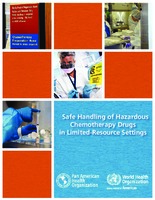Safe Handling of Hazardous Chemotherapy Drugs in Limited-Resource Settings
Date
2013ISBN
978-92-75-11801-6
Metadata
Show full item recordAbstract
[Background]. T he toxic effects of antineoplastic drugs used for cancer treatment have been well known since their introduction in the 1940s. However, beyond the patient safety concerns arising from the necessary therapeutic use of these drugs, the occupational risks to health care workers handling these drugs in the course of their duties still need to be fully addressed. Worldwide, more than 11 million new cases of cancer are diagnosed each year, and that number is expected to rise to 16 million by 2020 (WHO 2005). Treatment for many of these cases relies principally upon antineoplastic chemotherapy (Chabner et al. 1996). With approximately 100 different antineoplastic drugs now in use (NIOSH 2004, 2012) and many more under development, chemotherapy has opened new avenues, providing remission from the disease and the possibility of a cure in some cases. Addressing the formidable toxicity of these drugs, however, has been an ongoing challenge for clinicians and, more recently, for the occupational health community...In low-resource countries, where the more costly engineering solutions such as biologic safety cabinets may be prohibitively expensive, there is necessarily an overreliance on the other elements of the hazard control hierarchy. Identifying dedicated areas for hazardous chemotherapy drug storage and compounding, restriction of personnel access to these areas, meticulous adherence to work practices that minimize drug aerosol production and work environment contamination, together with painstaking attention to worker training and skills assessment are the most reasonable set of alternatives to the internationally recognized best-practices approach described above. This monograph describes in detail the rationale for and approaches to implementation of these alternative approaches to safe handling of hazardous chemotherapy drugs in low-resource settings.
Subject
Collections
Related items
Showing items related by title, author, creator and subject.
-
Müller-Ramírez, Claudio; Almashat, Sammy; Gaitens, Joanna; McDiarmid, Melissa (2023)[ABSTRACT]. Antineoplastic drugs (ANDs) used for chemotherapy can cause secondary cancers in treated patients and can pose carcinogenic risks to health-sector workers anywhere along these drugs’ life cycle in a facility, ...
-
Pan American Health Organization (PAHOUnited StatesWashington, D.C., 2019)Between 1970 and 2018, the Region of the Americas experienced over 4,500 disasters that killed 569,184 people and injured more than 3 million people. Additionally, emergencies and disasters of any kind can cause ...
-
Food and Agriculture Organization of the United Nations; Pan American Health Organization (PAHOUnited StatesWashington, D.C, 2017)[Introduction]. Introduction Food-borne diseases (FBDs) are one of the most frequent public health problems in daily life. The hazards that cause FBD may occur in the different stages of the food chain (from primary ...




